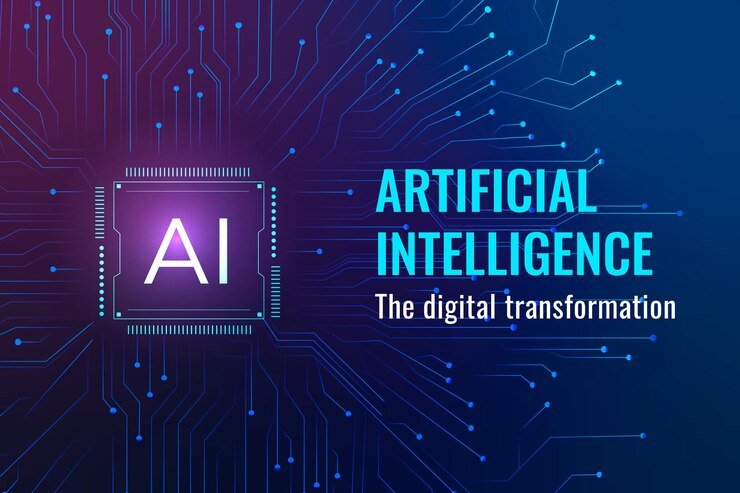
Artificial Intelligence (AI) is no longer a futuristic concept; it has become a fundamental part of modern life. From personal assistants like Siri and Alexa to self-driving cars and AI-driven healthcare solutions, AI is shaping the way we live, work, and interact with the world. But as the technology evolves, so do the challenges and ethical considerations that come with it. In this comprehensive exploration of the future of AI, we will delve into the latest trends, key challenges, and groundbreaking innovations that are transforming the tech industry. We’ll also address the impact of AI on jobs, privacy, and society at large, and what we can expect from this rapidly advancing field in the coming years.
Table of Contents
- Introduction to Artificial Intelligence
- Trends in Artificial Intelligence
- AI in Healthcare
- AI in Finance
- AI in Autonomous Vehicles
- AI in Retail and E-commerce
- AI in Cybersecurity
- AI and the Internet of Things (IoT)
- Challenges Facing AI Development
- Data Privacy and Security
- Ethical Concerns
- Bias in AI Algorithms
- The Challenge of AI Governance and Regulation
- Innovations Driving AI Forward
- Machine Learning and Deep Learning
- Natural Language Processing (NLP)
- AI-Powered Robotics
- Quantum Computing and AI
- AI in Edge Computing
- The Future of AI in the Workforce
- Automation and Job Displacement
- AI-Enhanced Roles
- Ethical and Social Implications of AI
- AI and Human Rights
- AI in Criminal Justice
1. Introduction to Artificial Intelligence
Artificial Intelligence, commonly referred to as AI, is the branch of computer science that aims to create machines capable of mimicking human intelligence. This includes tasks like learning, reasoning, problem-solving, understanding natural language, and even perception and decision-making. While AI as a concept has been around for decades, recent advances in computing power, big data, and machine learning algorithms have made AI more accessible and powerful than ever before.
Key Definition and Terminology
- Machine Learning (ML): A subset of AI that enables systems to learn from data and improve over time without being explicitly programmed.
- Deep Learning: A type of machine learning that uses neural networks with many layers (deep neural networks) to process and analyze large amounts of data.
- Natural Language Processing (NLP): The ability of AI to understand, interpret, and generate human language.
AI is a transformative technology, but it’s also highly dependent on data. The ability to process massive datasets and extract meaningful insights is key to the development and success of AI technologies.
2. Trends in Artificial Intelligence
AI is disrupting numerous industries, driving innovation, and leading to the development of new applications and solutions. Some of the most significant trends in AI include:
AI in Healthcare
The healthcare industry is one of the biggest beneficiaries of AI technology. From diagnosing diseases to personalizing treatments, AI is transforming healthcare. For instance:
- AI-powered diagnostic tools: Machine learning algorithms can analyze medical images to detect diseases like cancer at earlier stages, improving patient outcomes.
- Robotic surgery: AI-powered robotic systems assist surgeons in performing delicate procedures with precision.
- Predictive analytics: AI models predict patient outcomes and help in personalized treatment plans by analyzing vast amounts of health data.
AI in Finance
The finance sector has adopted AI to streamline processes, improve customer service, and enhance decision-making. Examples include:
- Algorithmic trading: AI systems can analyze market data faster and more accurately than human traders, enabling high-frequency trading.
- Fraud detection: AI algorithms can detect unusual patterns in financial transactions, flagging potential fraud before it happens.
- Personal finance management: AI chatbots and virtual assistants help users manage their finances by offering real-time advice and reminders.
AI in Autonomous Vehicles
The development of autonomous vehicles has gained momentum due to AI. Self-driving cars use AI algorithms to process sensory data from cameras, radar, and LIDAR to navigate roads safely.
- Tesla’s Autopilot and other companies like Waymo are pioneering the field of autonomous driving.
- AI in logistics: AI-driven logistics systems optimize routes, reducing delivery times and fuel consumption.
AI in Retail and E-commerce
AI has revolutionized the retail and e-commerce industries by enhancing customer experiences and optimizing business operations. Key applications include:
- Personalized recommendations: AI algorithms analyze user behavior to recommend products tailored to individual preferences.
- Supply chain management: AI optimizes inventory management, predicting demand, and minimizing overstocking or stockouts.
AI in Cybersecurity
Cybersecurity is a growing concern as cyberattacks become more sophisticated. AI helps to detect and mitigate these threats by:
- Anomaly detection: AI systems can detect unusual patterns in network traffic or user behavior, flagging potential security breaches.
- Automated threat response: AI can respond to cyber threats in real-time, shutting down systems or isolating infected devices to prevent the spread of malware.
AI and the Internet of Things (IoT)
The convergence of AI and IoT has led to the development of smart devices that can learn from their environment and users. These devices include:
- Smart home systems: AI-powered devices like smart thermostats and security cameras adapt to user habits and provide more personalized experiences.
- Industrial IoT (IIoT): AI is used to predict equipment failures, improving maintenance schedules and reducing downtime in industries like manufacturing.
3. Challenges Facing AI Development
Despite the exciting advancements in AI, there are significant challenges that need to be addressed to fully realize its potential. Some of these challenges include:
Data Privacy and Security
AI systems require vast amounts of data to function effectively. However, collecting, storing, and analyzing this data poses significant privacy and security risks.
- Data breaches: AI systems are prime targets for hackers due to the sensitive information they handle.
- GDPR and regulations: The rise of AI has led to stricter regulations regarding data privacy, such as the European Union’s General Data Protection Regulation (GDPR).
Ethical Concerns
AI has sparked a global debate about ethics, particularly regarding its potential for misuse.
- Autonomous weapons: There are concerns that AI could be used to develop autonomous weapons systems, leading to ethical dilemmas in warfare.
- Surveillance: AI-driven surveillance systems raise concerns about privacy and the potential for misuse by governments and organizations.
Bias in AI Algorithms
AI systems are only as good as the data they are trained on. If the training data is biased, the AI system will also be biased, leading to discriminatory outcomes in areas like hiring, lending, and law enforcement.
The Challenge of AI Governance and Regulation
Governments and regulatory bodies are still figuring out how to govern AI development and use. Striking a balance between innovation and regulation is a major challenge as AI continues to evolve.
4. Innovations Driving AI Forward
AI development is being propelled by several cutting-edge innovations, including:
Machine Learning and Deep Learning
Advances in machine learning, particularly deep learning, have been instrumental in improving AI’s ability to learn from data and make decisions.
Natural Language Processing (NLP)
NLP is driving breakthroughs in AI’s ability to understand and generate human language, leading to better voice assistants, chatbots, and translation services.
AI-Powered Robotics
AI-driven robots are becoming more advanced, enabling them to perform tasks in manufacturing, healthcare, and even household chores.
Quantum Computing and AI
Quantum computing holds the potential to revolutionize AI by providing the computational power necessary to solve complex problems that are currently beyond the reach of traditional computers.
AI in Edge Computing
Edge computing, where data is processed closer to the source rather than in a centralized cloud, is enhancing the capabilities of AI, particularly in real-time applications like autonomous vehicles and IoT devices.
5. The Future of AI in the Workforce
As AI continues to advance, its impact on the workforce is inevitable. While some fear that AI will lead to widespread job losses, others believe it will create new opportunities.
Automation and Job Displacement
AI-powered automation is expected to replace many routine jobs, particularly in industries like manufacturing and logistics. However, this displacement will be offset by the creation of new roles in AI development, data science, and AI-enhanced sectors.
AI-Enhanced Roles
Rather than replacing jobs, AI is likely to augment human workers by taking over repetitive tasks, allowing employees to focus on more complex, creative, and strategic aspects of their roles.
6. Ethical and Social Implications of AI
AI’s rapid advancement brings a range of ethical and social implications, including:
AI and Human Rights
AI can both help and hinder human rights. While it has the potential to improve access to education, healthcare, and justice, it also poses risks related to privacy, surveillance, and discrimination.
AI in Criminal Justice
AI systems are increasingly being used in criminal justice to predict crime and assist in sentencing. However, the use of biased data in these systems can lead to unfair outcomes, disproportionately affecting certain groups.
Conclusion: Navigating the Future of AI
The future of artificial intelligence is both exciting and uncertain. While AI holds tremendous potential to revolutionize industries and improve lives, it also presents significant challenges that must be addressed. As AI continues to evolve, it’s essential to navigate these challenges thoughtfully, ensuring that the technology benefits
